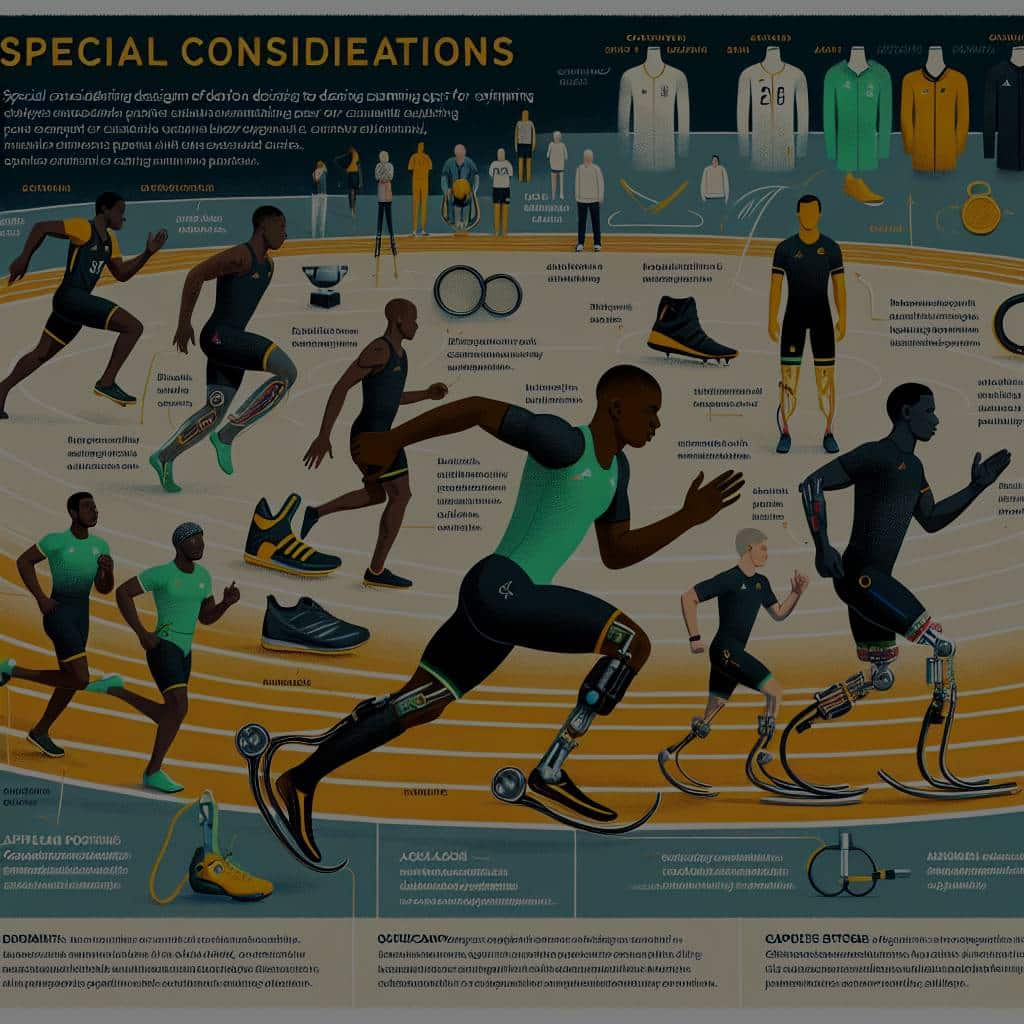The world of sport is an ever-evolving landscape. Advances in technology and a deeper understanding of the human body have led to the development of equipment and sportswear that can significantly enhance an athlete’s performance. This has been particularly beneficial for Paralympic athletes, providing them with the means to overcome physical limitations and compete at an elite level. Today, we will delve into the special considerations that come into play when designing sports gear for Paralympic sprinters.
Understanding the Athlete’s Body
In order to design effective sports gear for Paralympic sprinters, it’s integral to understand the unique physical conditions and needs of these athletes. This involves thorough studies and detailed examination of the athlete’s body.
Topic to read : How Can Real-Time GPS Monitoring Enhance Endurance Training for Adventure Racers?
Each athlete’s disability presents a unique challenge for designers. For instance, a sprinter with a lower limb amputation will require different support and equipment than a wheelchair-bound participant. Therefore, a comprehensive understanding of the athlete’s physical capabilities, limitations and needs is crucial in the design process.
Multiple studies have been conducted on how different disabilities affect an athlete’s performance. For example, researchers have extensively studied the impact of lower limb amputation on running biomechanics. Such studies provide valuable insights that guide the design of specialized equipment like running blades.
Also to see : How to Implement Video Analysis in Referee Training for Better Decision Making in Football?
Incorporating Technology in Design
Technology plays an instrumental role in designing sports gear for Paralympic sprinters. State-of-the-art equipment like motion capture systems and sensors are used in the study of an athlete’s body movement and performance. These technologies help in designing gear that not only improves performance but also reduces the risk of injuries.
Advanced sensors can track and record detailed data about an athlete’s movement, force exertion, and body position. This data is then analyzed to gain insights into the athlete’s performance and possible areas of improvement. For instance, sensors can be used to measure the force exerted by a wheelchair athlete while pushing the wheels. This data can then be used to design wheelchairs that maximize the athlete’s strength and stamina.
Similarly, motion capture technology is used to study the body movements of athletes during a sprint. This helps in designing sportswear that enhances the athlete’s mobility and comfort while ensuring optimal aerodynamics.
Ensuring Safety and Comfort
Safety and comfort are paramount considerations when designing sports gear for Paralympic sprinters. Given the physical challenges faced by these athletes, the design must ensure that they do not face any additional strain or risk of injury.
For wheelchair athletes, for instance, the wheelchair design should ensure optimal stability and maneuverability. It should be lightweight yet robust, and its design should allow the athlete to exert maximum force while minimizing strain. Comfortable seating, effective braking systems, and smooth mobility are other key considerations in wheelchair design.
For athletes with prosthetics, the design considerations are significantly different. The prosthetic limb should be designed to mimic the natural movement of the limb as closely as possible. It should be lightweight, yet strong enough to withstand the intense pressure exerted during a sprint. The design should also ensure optimal shock absorption to minimize strain on the residual limb.
Adhering to Paralympic Regulations
Every piece of equipment used in Paralympic sports, including sportswear and wheelchairs, must adhere to strict regulations set by the International Paralympic Committee. These regulations ensure fair competition and maintain the spirit of the Paralympic games.
For instance, the design of prosthesis for athletes with a lower limb amputation must comply with the regulations regarding the length, weight, and shape of the prosthesis. Similarly, the design of wheelchairs for athletics must comply with the specifications regarding the size, weight, and construction of the wheelchair.
Designers must stay updated with the latest regulations and ensure that their designs are in full compliance. This often requires close collaboration with the athletes, coaches, and regulatory bodies.
Customizing the Design
Lastly, customization plays a key role in designing sports gear for Paralympic sprinters. Each athlete is unique in their physical capabilities, preferences, and performance style. Therefore, sports gear should ideally be designed to cater to each athlete’s individual needs.
A one-size-fits-all approach does not work in this scenario. Instead, designers should work closely with the athletes, understand their specific needs and preferences, and design the equipment accordingly. This could involve customizing the design of a prosthetic limb, the fit and material of sportswear, or the features of a wheelchair.
In conclusion, designing sports gear for Paralympic sprinters involves a careful balance of understanding the athlete’s body, incorporating technology, ensuring safety and comfort, adhering to regulations, and customizing the design. With the continual advancement in technology and design, the potential to enhance the performance and experience of Paralympic sprinters is boundless.
Case Study: Developing Sports Equipment for Disabled Athletes in Sri Lanka
In this section, we’ll examine a case study of how sports equipment for disabled athletes is being developed in developing countries. For instance, let’s take a look at Sri Lanka, where innovative solutions are being employed to make sports more accessible to people with disabilities.
Sri Lanka has a significant population of individuals living with disabilities. Unfortunately, access to high-quality sports equipment needed to participate in activities such as wheelchair rugby and wheelchair basketball is not always readily available. To address these challenges, the design process in Sri Lanka has taken on a grassroots approach, focusing on the utilization of resources available locally.
For instance, instead of importing expensive wheelchairs designed for wheelchair rugby or basketball, local designers have started creating their own. These locally-made chairs are not only affordable but are also designed keeping in mind the unique needs of the Sri Lankan athletes.
One of the key components utilized in this process is wearable sensors. These sensors are used to track and analyze the athletes’ movements while playing wheelchair sports. The data collected is then used to refine the design of the wheelchairs, focusing specifically on enhancing wheelchair propulsion and player comfort.
Despite the many challenges faced, Sri Lanka’s example provides a pioneering model. It showcases the possibility of creating high-performance sports equipment for disabled athletes in developing countries. It also highlights the potential role of wearable technologies in improving the design and performance of sports gear for Paralympic athletes.
Athlete Classification and Apparel Design in Cross Country
In Paralympic games such as cross country, understanding athlete classification is crucial in the design of sportswear. It is vital to understand that each athlete has distinct needs based on their disability classification. For instance, an athlete with a lower limb impairment will have different sportswear needs from those with upper limb impairments.
In the realm of apparel design, designers need to consider a multitude of factors. The design considerations include the athlete’s range of motion, the type of disability, the demands of the specific sport, and the individual athlete’s preferences.
For example, sportswear designed for an athlete participating in wheelchair cross country would need to facilitate easy wheelchair propulsion. It should also offer resistance to environmental elements, like wind or rain, thus requiring specialized materials and design techniques.
In contrast, sportswear for a visually impaired cross country runner might need to be designed with high-visibility colors and patterns for safety. The design should also minimize any potential distractions, such as loose or fluttering fabric, that could interfere with the athlete’s performance.
In both scenarios, the comfort of the athlete is of utmost importance. The sportswear design should not only enhance performance but also minimize any discomfort or potential for injury.
Conclusion
Designing sports gear for Paralympic athletes is a complex yet fascinating process. It requires a deep understanding of the athlete’s body, the integration of advanced technologies, and a keen eye for design considerations that will ensure both safety and comfort. Moreover, designers need to account for strict Paralympic regulations to maintain fair competition.
The case study of Sri Lanka highlights the potential for innovation in developing countries, inspiring other nations to follow suit. The use of wearable sensors and other technologies can greatly enhance the design process, providing valuable insights into the athlete’s performance and needs.
In the realm of sportswear design, understanding athlete classification is critical. Each athlete’s unique needs and preferences should be taken into account for a truly effective and comfortable design.
The continued evolution in sports technology and apparel design leaves us with a sense of excitement for the future of Paralympic sports. As we improve our understanding and technology, the possibilities for enhancing the performance and experience of disabled athletes are limitless.






